Automotive Applications for Embedded Vision
Vision products in automotive applications can make us better and safer drivers
Vision products in automotive applications can serve to enhance the driving experience by making us better and safer drivers through both driver and road monitoring.
Driver monitoring applications use computer vision to ensure that driver remains alert and awake while operating the vehicle. These systems can monitor head movement and body language for indications that the driver is drowsy, thus posing a threat to others on the road. They can also monitor for driver distraction behaviors such as texting, eating, etc., responding with a friendly reminder that encourages the driver to focus on the road instead.
In addition to monitoring activities occurring inside the vehicle, exterior applications such as lane departure warning systems can use video with lane detection algorithms to recognize the lane markings and road edges and estimate the position of the car within the lane. The driver can then be warned in cases of unintentional lane departure. Solutions exist to read roadside warning signs and to alert the driver if they are not heeded, as well as for collision mitigation, blind spot detection, park and reverse assist, self-parking vehicles and event-data recording.
Eventually, this technology will to lead cars with self-driving capability; Google, for example, is already testing prototypes. However many automotive industry experts believe that the goal of vision in vehicles is not so much to eliminate the driving experience but to just to make it safer, at least in the near term.
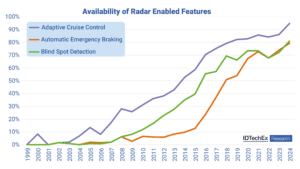
The Rising Role of Radar in the Future of ADAS and Autonomous Driving
Availability of radar-enabled features. IDTechEx‘s report, “Automotive Radar Market 2025-2045: Robotaxis & Autonomous Cars“, predicts the automotive radar market will hit 500 million annual sales in 2041. This article takes a look at the role of radar in the future of advanced driver-assistance systems (ADAS) and autonomous driving, including market segmentation, regulatory catalysts, and regional
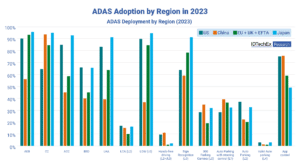
L2+ ADAS Outpaces L3 in Europe, US$4B by 2042
14 ADAS Features Deployed in EU. Privately owned Level 3 autonomous vehicles encountered significant regulatory setbacks in 2017 when Audi attempted to pioneer the market with the L3-ready A8. Regulatory uncertainty quickly stalled these ambitions, delaying the introduction of true L3 autonomy. By 2021, a clearer regulatory framework emerged under UNECE guidelines, affecting Europe and
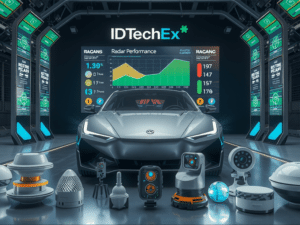
Radar-enhanced Safety for Advancing Autonomy
Front and side radars may have different primary uses and drivers for their innovation, but together, they form a vital part of ADAS for autonomous vehicles. IDTechEx‘s report, “Automotive Radar Market 2025-2045: Robotaxis & Autonomous Cars“, showcases the latest radar developments and explores autonomy leveling up as a result, with Level 2+ asserting itself within

NVIDIA Announces Major Release of Cosmos World Foundation Models and Physical AI Data Tools
New Models Enable Prediction, Controllable World Generation and Reasoning for Physical AI Two New Blueprints Deliver Massive Physical AI Synthetic Data Generation for Robot and Autonomous Vehicle Post-Training 1X, Agility Robotics, Figure AI, Skild AI Among Early Adopters March 18, 2025—GTC—NVIDIA today announced a major release of new NVIDIA Cosmos™ world foundation models (WFMs), introducing
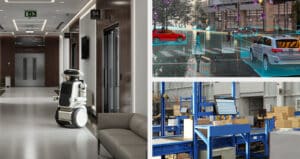
NVIDIA Unveils Open Physical AI Dataset to Advance Robotics and Autonomous Vehicle Development
Expected to become the world’s largest such dataset, the initial release of standardized synthetic data is now available to robotics developers as open source. Teaching autonomous robots and vehicles how to interact with the physical world requires vast amounts of high-quality data. To give researchers and developers a head start, NVIDIA is releasing a massive,
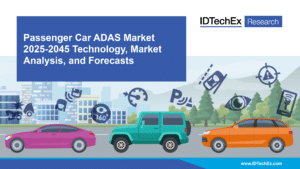
Passenger Car ADAS Market 2025-2045: Technology, Market Analysis, and Forecasts
For more information, visit https://www.idtechex.com/en/research-report/passenger-car-adas-market-2025-2045-technology-market-analysis-and-forecasts/1080. Global L2+/L3 feature adoption will exceed 50% by 2035. Over the past few years, Advanced Driver Assistance Systems (ADAS) have become a core competitive factor in the passenger vehicles market. In particular, “Level 2+” has emerged as a term describing advanced Level 2 ADAS with more sophisticated capabilities, such as
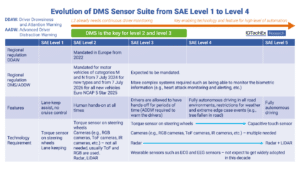
Insights from CES 2025: In-cabin Sensing and Software-defined Vehicles
Regulatory landscape and SAE level. As regulatory frameworks such as the EU’s Advanced Driver Distraction Warning (ADDW) near enforcement, automotive OEMs increasingly integrate in-cabin sensing technologies with software-defined vehicle architectures. This shift, evident at CES 2025, marks a pivotal moment in the automotive industry as OEMs leverage existing hardware—such as infrared and RGB cameras—to develop
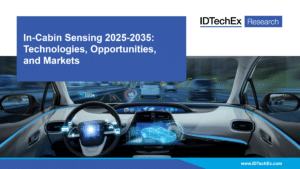
In-cabin Sensing 2025-2035: Technologies, Opportunities, and Markets
For more information, visit https://www.idtechex.com/en/research-report/in-cabin-sensing-2025-2035-technologies-opportunities-and-markets/1077. The Yearly Market Size for In-cabin Sensors will Exceed $6B by 2035 Regulations like the Advanced Driver Distraction Warning (ADDW) and General Safety Regulation (GSR) are driving the growing importance of in-cabin sensing, particularly driver and occupancy monitoring systems. IDTechEx’s report, “In-Cabin Sensing 2025-2035: Technologies, Opportunities, Markets”, examines these regulations
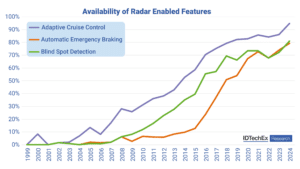
Nearly $1B Flows into Automotive Radar Startups
According to IDTechEx‘s latest report, “Automotive Radar Market 2025-2045: Robotaxis & Autonomous Cars“, newly established radar startups worldwide have raised nearly US$1.2 billion over the past 12 years; approximately US$980 million of which is predominantly directed toward the automotive sector. Through more than 40 funding rounds, these companies have driven the implementation and advancement of
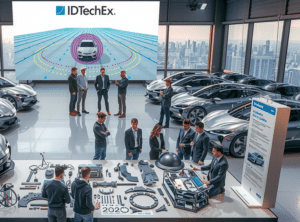
Top-tier ADAS Systems: Exploring Automotive Radar Technology
Radars have had a place within the automotive sector for over two decades, beginning with the first use for adaptive cruise control and many other developments taking place since. IDTechEx‘s “Automotive Radar Market 2025-2045: Robotaxis & Autonomous Cars” report explores the latest developments in radar technology within the automotive sector. ADAS safety systems ADAS (advanced

